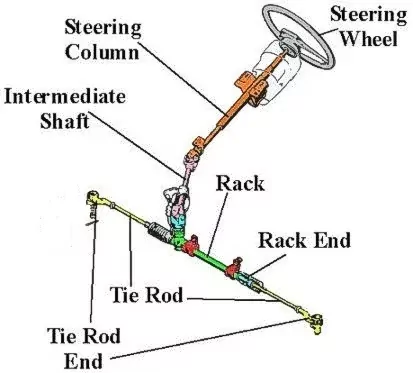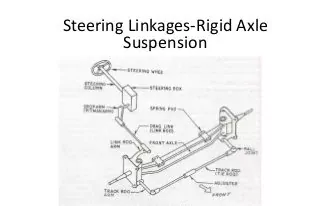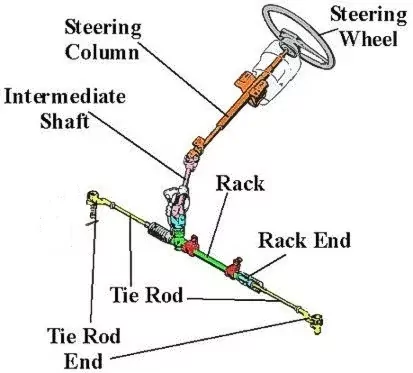Table of Contents
Steering System


The steering system allows the driver to guide the moving vehicle on the road and turn it right or left as the Desires.
During steering, the movement of the wheel must be positive and exact and no wheel should slide on the road. This aspect is influenced by the steering linkage mechanism, tyre and road conditions and vehicle suspension system.
Requirement of steering system
1) The steering mechanism should be very accurate and easy to handle.
2) It should multiply the turning effort applied on the steering wheel by the driver.
3) It should be a certain degree Irreversible so that the shocks on the road surface encountered by the wheel are not transmitted to the driver hands.
4) The steering mechanism should have self-rightening effect so that when the driver release the steering wheel after negotiating a turn, the wheel should try to achieve straight ahead position.
The function of a steering system
The steering system in a vehicle is a crucial component that allows the driver to control the direction of the vehicle. Its primary function is to facilitate the maneuvering of the vehicle by allowing the driver to change the direction in which the wheels are pointing. The key elements of a typical steering system include the steering wheel, steering column, steering gear, and the linkage that connects the steering gear to the wheels.
Main functions of a steering system
Directional Control: The primary function of the steering system is to enable the driver to control the direction in which the vehicle moves. Turning the steering wheel causes the wheels to turn, allowing the vehicle to change its course.
Driver Input Transmission: When the driver turns the steering wheel, the steering system transmits this input to the wheels. This can be achieved through various mechanisms, such as rack and pinion, recirculating ball, or other steering gear systems.
Assistive Technologies: Many modern vehicles are equipped with power steering systems that assist the driver in turning the wheels more easily, especially at low speeds or when the vehicle is stationary. Power steering can be hydraulic or electric, and it helps reduce the effort required to turn the steering wheel.
Feedback Mechanism: The steering system provides feedback to the driver about the road conditions and the vehicle’s response. This feedback is important for the driver to have a sense of control and awareness of the road.
Alignment Maintenance: The steering system contributes to maintaining proper wheel alignment. Proper wheel alignment ensures that the vehicle travels straight with minimal resistance and tire wear. Misalignment can lead to handling issues and uneven tire wear.
Safety: A well-functioning steering system is crucial for the safety of the vehicle and its occupants. It allows the driver to react quickly to changes in road conditions, avoid obstacles, and navigate through traffic.
The Parts of The Steering System
The steering system in a vehicle is designed to allow the driver to control the direction of the vehicle. It consists of several components that work together to facilitate smooth and responsive steering.
The main parts of a typical steering system include:
Steering Wheel:
The steering wheel is the primary interface between the driver and the steering system. It is turned by the driver to control the direction of the vehicle.
Steering Column:
The steering column is a shaft that connects the steering wheel to the steering gearbox or rack. It may also house various controls, such as the turn signal switch and ignition switch.
Steering Gearbox:
In vehicles with a recirculating ball steering system, the gearbox is a component that translates the rotational motion of the steering wheel into lateral motion to turn the wheels. In vehicles with rack-and-pinion steering, the gearbox is replaced by the rack and pinion mechanism.
Rack and Pinion:
In rack-and-pinion steering systems, the rack is a linear gear that meshes with a pinion gear connected to the steering column. As the steering wheel is turned, the rack moves laterally, turning the vehicle’s wheels.
Power Steering Pump:
Many modern vehicles are equipped with power steering, which uses a hydraulic pump to assist the driver in turning the steering wheel. The power steering pump is responsible for generating hydraulic pressure to aid in steering.
Power Steering Fluid:
Power steering fluid is used in power steering systems to transmit hydraulic pressure and lubricate the system. It is essential for the proper functioning of power steering components.
Tie Rods:
Tie rods are connected to the ends of the rack (or steering gearbox) and link the steering system to the wheels. They transmit the steering input from the rack to the wheels, allowing them to turn.
Ball Joints:
Ball joints connect the steering knuckles to the control arms. They allow for the movement and rotation of the front wheels.
Steering Knuckles:
Steering knuckles are components that connect the wheel hubs and bearings to the vehicle’s suspension and steering components.
Pitman Arm and Idler Arm:
In some steering systems, such as those with a recirculating ball mechanism, the pitman arm and idler arm are used to transmit motion from the steering gearbox to the tie rods.
Steering Linkage:
The steering linkage consists of various connecting rods and arms that link the steering components together, ensuring coordinated movement.
Steering linkages
In all type of steering systems, there is a cross shaft in the steering box. Which is operated by means of steering wheel through a rod in the hollow steering column and some type of steering gear.
The cross shaft is further connected to a drop arm also called pitman at its end. Thus the rotation of steering wheel results in the linear motion of the drop arm at it’s end which itself is connected through a ball joint to a link rod.
To meet different requirement of different vehicle different steering linkages having individual variations are used some important type steering linkage are direct cross type, Centre are steering, three piece steering etc.
A) Steering linkage for rigid axle suspension


Figure shows steering linkage for a conventional rigid axle suspension. The link rod causes the turning of the front wheel through the steering arms and the track rod.
The track rod and steering arms are connect by ball joint. The design of ball joint it such that the expanding spring compansates for wear and miss adjustment in the system.
A provision for change the length of track rod is also provided. In this steering linkage only one wheel is positively steered.
B) Steering linkage for independent suspension
In independent suspension, a provision has to be made regarding the motion of wheels relative to each other, to keep the steering geometry correctly at all time.
Figure shows to track rod are provided and a centrally idler arm actuate the two piece track rod. In this case both the wheel are positively steered.
Rack and pinion steering gear


In this type of steering gear, a pinion is mounted at the end of steering shaft. The pinion engages with the rack which is provided with ball joint at its each end in order to allow for the rise and fall of wheel.
The rotary motion of the steering wheel is transmitted to the pinion.
The circular motion of pinion is convert into the linear rack movement, which is further transmitted to tie rods to the stub axle through ball joint.
This type of steering gear provides sufficiently low gear reduction for car and it is quite suitable even for heavier motor vehicles if assisted with power. It occupies very small space and less number of linkage.
The rack and pinion gear design are of two type
1) Centre take off rack
In this tie rods are connected at the centre of the rack in instead of at the end. It has a large boot that covers the centre part of the rack and pinion housing. A slot in the housing permit the inner tie rode ends to move with the rack.
This type of design can be mounted high saving space and reduces the length of steering column.
2) End take off rack
In this tie rod is connected at the end of the rack this is less affected by bump steer. When the toe of wheel changes as they go over the bump, the vehicle is said to have bump steer.
Recirculating Ball type steering Gear


It is an improvement version of the worm and nut steering gear. It consist of a worm at the end of steering rod. A nut is mounted on worm with two set of balls in the grooves of the worm, in between the nut and worm.
The function of ball is to reduce the friction between the worm and nut. The nut has a number of teeth on the outside which mesh with the teeth on worm wheel sector.
The Drop arm is mounted on sector. Which transfer the motion to steering arms through linkages. When the steering wheel turn, the balls in the worm grove rolls, causes to nut slides on the worm. This linear motion of nut causes the wheel sector turn at an angle and actuate the link rod through drop arm, resulting in the desired steering of the wheels.
The end play of the worm can be adjusted with the help of adjuster nut provided. A screw is also provide by means of which the drop arm and hence the wheel sector can be positioned along its axis.
Introduction to Power Steering


With increasing demand for light control aligning tyre torque for keeping vehicle load acceptable, power steering has become necessity in most of the vehicle.
In order to reduce the steering wheel turning effort, turn sharp corner easily, negotiate winding roads and monocurve the vehicle in confirmed space as well as to offer some resistance to make the drive feel and retain some road feel or vehicle steering response power steering has been used.
Now, In heavy duty truck and power tractors the effort applied by the driver is inadequate to turn the Wheels. In this case a booster arrangement is incorporated in the steering system.
The booster is set into operation when the steering wheel is turned. The booster then takes over and does most of the work for the steering. This system called power steering has used compressed air, electrical mechanisms and Hydraulic pressure.
Hydraulic pressure is used on the vast majority of power steering mechanism today. A simplified sketch of hydraulic power steering with hydraulic booster shown in figure.
Steering System – How does a steering system work & More
When the steering wheel is turned, the worm turns the sector of worm wheel and the arm.
The arm turns the road Wheel by means of the drag link. If the resistance offered to turn the wheels is too high and the effort applied by the driver to the steering wheel is to weak, then the worm, like a screw in a nut will be displayed axially together with the distributor slide valve.
The axial movement of the distributor slide valve in the cylinder will admit oil into the booster cylinder through the pipeline.
The piston in the booster cylinder will turn the road wheels via the gear rack, the toothed worm sector, arm and drag link. At the same time, the worm sector will act upon the worm and will shift it together with the distribution slide valve to it initial position and stop the piston travel in the boost cylinder.
When the steering wheel is turned in the other direction, the wheels will be turned appropriately in the same sequence.
The more the steering mechanism and wheels resist turning, the more the control valve is displaced. Hence, power assistance is always supplied in proportion to the effort needed to turn the wheel.
What are common issue with a steering system?
Various issues can arise in a vehicle’s steering system, affecting its performance and safety.
Some common problems associated with steering systems:
Alignment Issues:
Symptoms: Vehicle pulling to one side, uneven tire wear.
Causes: Misaligned wheels, worn-out suspension components.
Loose or Wandering Steering:
Symptoms: Excessive play in the steering wheel, a feeling of wandering or vagueness.
Causes: Worn-out steering components, loose or damaged tie rods, ball joints, or bushings.
Hard Steering:
Symptoms: Difficulty turning the steering wheel, especially at low speeds.
Causes: Low power steering fluid, a malfunctioning power steering pump, a faulty steering rack, or a worn-out steering gear.
Fluid Leaks:
Symptoms: Puddles or spots of power steering fluid under the vehicle.
Causes: Leaking hoses, seals, or a damaged power steering pump.
Unusual Noises:
Symptoms: Grinding, whining, or clunking sounds when turning the steering wheel.
Causes: Worn-out or damaged bearings, joints, or other steering components.
Vibration in the Steering Wheel:
Symptoms: Vibrations felt in the steering wheel while driving.
Causes: Unbalanced or damaged tires, bent wheels, or issues with the suspension system.
Steering Wheel Doesn’t Return to Center:
Symptoms: The steering wheel does not return to the center after making a turn.
Causes: Misaligned wheels, problems with the steering column, or issues with the steering gear.
Excessive Steering Effort:
Symptoms: Requiring more effort than usual to turn the steering wheel.
Causes: Low power steering fluid, a failing power steering pump, or problems with the steering gear.
Electronic Power Steering (EPS) Issues:
Symptoms: Malfunction warning light, loss of power assistance.
Causes: Faulty sensors, electronic control unit (ECU) issues, or problems with the EPS motor.
Tie Rod Issues:
Symptoms: Uneven tire wear, clunking noises, poor alignment.
Causes: Worn-out or damaged tie rods, which connect the steering system to the wheels.
Power Steering vs. Manual Steering
Power steering and manual steering are two different types of steering systems in automobiles, each with its own set of characteristics and advantages.
Manual Steering:
Mechanical Connection: In a manual steering system, there is a direct mechanical connection between the steering wheel and the wheels on the vehicle.
Driver Effort: Turning the steering wheel requires physical effort from the driver, as there is no power assistance. This can be more challenging, especially at low speeds or when parking.
Simplicity: Manual steering systems are simpler in design and have fewer components. They are often found in older vehicles or in performance-oriented cars where a direct and connected feel is preferred.
Power Steering:
Power Assistance: Power steering systems use hydraulic or electric assistance to make it easier for the driver to turn the steering wheel.
Driver Effort: With power steering, the driver doesn’t need to exert as much physical effort to turn the wheel, making it more convenient, especially at low speeds or when parking.
Types of Power Steering:
Hydraulic Power Steering (HPS): Uses hydraulic fluid and a pump to provide assistance.
Electric Power Steering (EPS): Uses an electric motor for power assistance, often more fuel-efficient than hydraulic systems.
Variants:
Hydraulic power steering (HPS): Common in older vehicles and some modern trucks and SUVs.
Electric power steering (EPS): Increasingly common in modern vehicles due to its efficiency and flexibility.
Factors to Consider:
Fuel Efficiency: Generally, manual steering systems are more fuel-efficient as they do not require power from the engine.
Convenience: Power steering provides added convenience, especially in urban driving conditions and when maneuvering at low speeds.
Maintenance: Manual steering systems are simpler and may require less maintenance, whereas power steering systems may have more components that can require attention.
Preference: Some drivers prefer the direct and connected feel of manual steering, while others appreciate the ease of use provided by power steering.
FAQ’s
What is the steering system?
The steering wheel turns a pinion, which moves a rack back and forth to turn the wheels. This mechanism converts the circular motion of the steering wheel into linear motion, which is applied to the wheels of the car using tie rods and a steering knuckle.
What are the 3 types of direction?
There are three basic types of power steering systems found in vehicles: hydraulic power steering (HPS), electric power steering (EPHS), and fully electric power steering (EPS).
You may also like

[…] Steering System […]